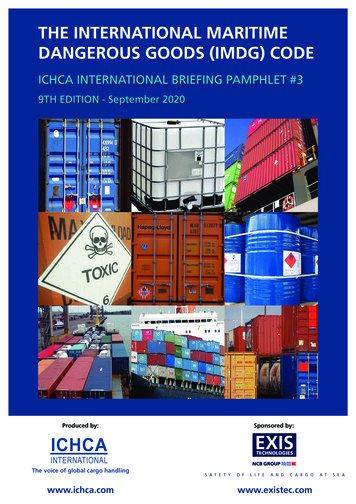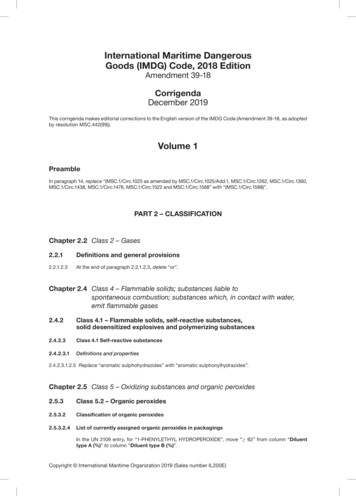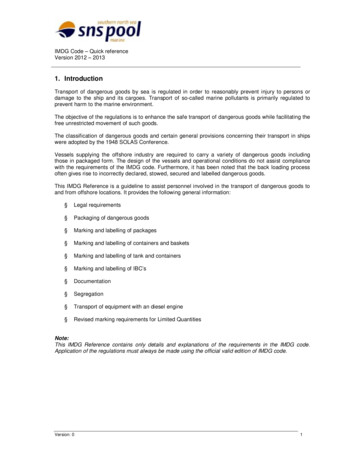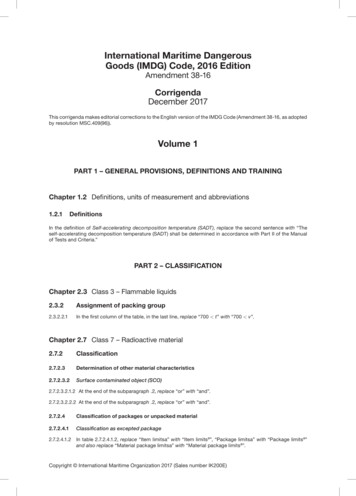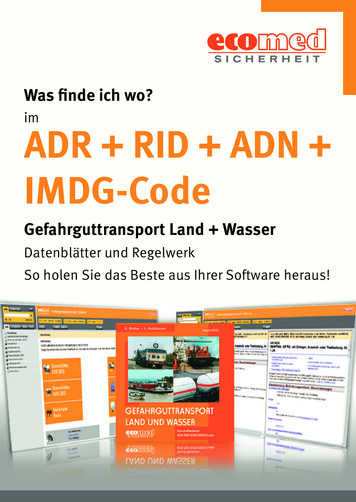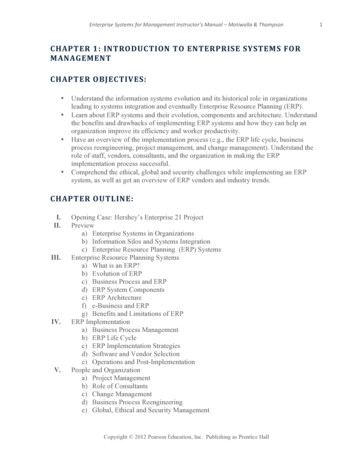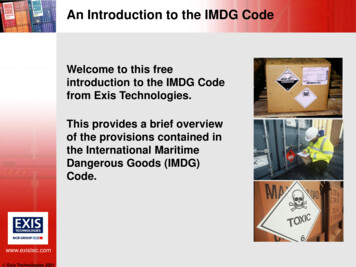
Transcription
An Introduction to the IMDG CodeWelcome to this freeintroduction to the IMDG Codefrom Exis Technologies.This provides a brief overviewof the provisions contained inthe International MaritimeDangerous Goods (IMDG)Code.www.existec.comwww.existec.com Exis Technologies 2018 Exis Technologies 2021
What is the IMDG Code?The International Maritime Dangerous Goods (IMDG) Codecontains provisions for the safe carriage of dangerousgoods by sea.The key objectives are to: protect human life prevent marine pollution facilitate the free movement ofdangerous goods.www.existec.comwww.existec.com Exis Technologies 2018 Exis Technologies 2021
What is the IMDG Code?The International Maritime Organization (IMO)The IMDG Code is produced by the International MaritimeOrganization (IMO), a specialist United Nations (UN) agencyresponsible for developing and maintaining regulatory frameworksfor sea transport.The Code’s provisions are based on recommendations developedby the UN and published in ‘Recommendations on the Transport ofDangerous Goods’. These regulations provide a uniform frameworkof rules for the safe transport of dangerous goods by all modes –air, road and rail as well as sea.www.existec.comwww.existec.com Exis Technologies 2018 Exis Technologies 2021
What are dangerous goods?What are dangerous goods and why are they useful?Dangerous goods are substances or articles which can pose athreat to people, property and/or the environment.They can exist in three physical states – as a solid, liquid or gas –and can present a range of dangers in a transport environment –flammability, toxicity (poisonous) and corrosivity being the mostcommon.The physical state and properties affect packing, handling andtransport decisions.Many dangerous goods are essential in the manufacture of otherproducts such as cars, plastics, electronics and pharmaceuticalson which progress and world trade depend.www.existec.comwww.existec.com Exis Technologies 2018 Exis Technologies 2021
Different types of dangerous goodsFor transport purposes, dangerous goods are allocated to one of nine‘classes’, according to the main danger they present. These are asfollows:Class 1 - ExplosivesClass 2 - GasesClass 3 - Flammable liquidsClass 4 - Flammable solids; substances liable to spontaneous combustion;substances which, in contact with water, emit flammable gasesClass 5 - Oxidizing substances and organic peroxidesClass 6 - Toxic and infectious substancesClass 7 - Radioactive materialClass 8 - Corrosive substancesClass 9 - Miscellaneous dangerous substances and articles (Class 9) andenvironmentally hazardous substanceswww.existec.comwww.existec.com Exis Technologies 2018 Exis Technologies 2021
Different types of dangerous goodsMany of the classes are sub-divided. For example, toxic substancesare allocated to Class 6.1; infectious substances are allocated toclass 6.2.Substances or articles are classified as ‘dangerous goods’ for seashipment if they meet the classification criteria prescribed in theIMDG Code for any of these classes.The danger(s) presented by a particular substance or articledetermine the safe transport procedures for it e.g. the way it needs tobe packed, whether it can be loaded in the same freight container asother dangerous goods, where it needs to be stored within the port orstowed on board the ship.www.existec.comwww.existec.com Exis Technologies 2018 Exis Technologies 2021
Identifying Dangerous GoodsEach class has a unique diamond label used to identify danger intransport.www.existec.comwww.existec.com Exis Technologies 2018 Exis Technologies 2021
Identifying Dangerous GoodsAll dangerous goods are uniquely identified for transport by UNNumbers and Proper Shipping Names (PSNs).The UN Number and PSN facilitate rapid and precise identificationduring transport to ensure correct handling, stowage, segregationetc., and appropriate actions in an emergency.www.existec.comwww.existec.com Exis Technologies 2018 Exis Technologies 2021
Identifying Dangerous GoodsIn the example below we can see that ‘Kerosene’ is classified as aflammable liquid (class 3); ‘KEROSENE’ is the recognised PSN; theUN Number for it is UN 1223.This screenshot is taken from Hazcheck Online, a web-based systemfor checking stowage, segregation and packaging, and producing aDangerous Goods Note. Contact sales@existec.com for a free onemonth trial.www.existec.comwww.existec.com Exis Technologies 2018 Exis Technologies 2021
Application of the IMDG CodeThe IMDG Code’s requirements apply to all ships which are subject tothe following two conventions:International Convention for the Safety of Life at Sea, 1974(SOLAS 1974) – this covers the safety implications of dangerousgoods onboard ships; andInternational Convention for the Prevention of Pollution fromShips (MARPOL) – which covers the pollution aspects for shipscarrying dangerous goodswww.existec.comwww.existec.com Exis Technologies 2018 Exis Technologies 2021
Application of the IMDG CodeThe IMDG Code amplifies the relevant safety and pollutionprevention provisions of these Conventions.Most of the requirements in the IMDG Code apply on amandatory basis but there are a few provisions which arerecommendatory.The IMDG Code is applied automatically by the governments ofall the States which are members of SOLAS, and has aworldwide application to the movement of dangerous goods bysea.While some SOLAS Member Governments incorporate therequirements of the IMDG Code without amendment into theirnational legislation, others apply some different and/oradditional (usually more stringent) national requirements.www.existec.comwww.existec.com Exis Technologies 2018 Exis Technologies 2021
Application of the IMDG CodeOther international and national modal regulations also exist. Forexample, in many countries dangerous goods transport by roadtransport is covered under ADR. Compliance with these is required, asappropriate; they may recognise all or part of the provisions of theIMDG Code.When shipping dangerous goods, it is also important to be aware ofany further restrictions or requirements which may apply in a particularcountry or port.www.existec.comwww.existec.com Exis Technologies 2018Additionally, competent authorities may authorise, approve or grantexemptions from particular requirements of the IMDG Code.
Overview of the IMDG CodeThe IMDG Code requires certain provisions to be followed wheneverdangerous goods are shipped by sea.These provisions require that dangerous goods are correctly and safely: Classified and identified Packed Marked, labelled and placarded Documented Stowed on board the vessel Segregated from other goods with which they may react dangerouslyIn addition appropriate emergency response information must beavailable and security and training requirements must be followedwww.existec.comwww.existec.com Exis Technologies 2018
Layout of the IMDG CodeThe IMDG Code comprises 7 parts, presented in two volumes –Volume 1 and Volume 2.Both volumes must be used to obtain the required information andinstructions when dangerous goods are shipped by sea.There is also a Supplement which provides additional guidance.The IMDG Code is available in printed book, E-reader, Weband Intranet formats.www.existec.comwww.existec.com Exis Technologies 2018
Layout of the IMDG CodeVolume 1 contains most of the detailed instructions for safelypreparing and transporting dangerous goods by sea: www.existec.comwww.existec.com Exis Technologies 2018Part 1: General Provisions, Definitions, Training, Security andRadioactive Material TransportPart 2: ClassificationPart 4: Packing and Tank ProvisionsPart 5: Consignment ProceduresPart 6: Construction and Testing of Packagings, IntermediateBulk Containers (IBCs), Large Packagings, Portable Tanks,Multiple Element Gas Containers (MEGCs) and Road TankVehiclesPart 7: Provisions Concerning Transport Operations
Layout of the IMDG CodeVolume 2 contains:www.existec.comwww.existec.com Exis Technologies 2018 Part 3: Dangerous Goods List (DGL), Special Provisions andExceptions (Limited and Excepted Quantities) Appendix A: List of Generic and N.O.S. Proper ShippingNames Appendix B: Glossary of terms Alphabetical Index: An alphabetical index of Proper ShippingNames, synonyms and other names
Dangerous Goods List (DGL)In the IMDG Code, most of the decisions on safe shipping andtransport procedures stem from the use of the DGL located inVolume 2.The DGL is an index of substances and articles, arranged in UNNumber order. It comprises 18 columns of information for each listedsubstance/article, presented as a two page spread in the printedbooks. Much of the information is in a coded form to make it easier topresent in a table.www.existec.comwww.existec.com Exis Technologies 2018
Dangerous Goods List (DGL)The meaning and implications of these codes are explained in therelevant chapters and sections of Volumes 1 and 2, an initial point ofreference being provided at the head of each column.For example, column 16b provides ‘SG’ segregation codes themeaning of which can be found in 7.2.8.Decisions on packing arrangements, marking and labellingrequirements, documentation entries, stowage, segregation and othershipping and transport duties generally stem from the columns of theDGL.www.existec.comwww.existec.com Exis Technologies 2018
Alphabetical IndexAt the end of Volume 2 of the IMDG Code, there is an alphabeticalindex of substances/articles.This can be used as the initial point of reference when the name ofthe substance rather than the UN Number is known.www.existec.comwww.existec.com Exis Technologies 2018
Layout of the IMDG Code SupplementThe IMDG Code Supplement contains the following sections relatedto the Code. Emergency Response Procedures for Ships Carrying DangerousGoods; Medical First Aid Guide; Reporting Procedures; Safe Use of Pesticides in Ships, in CTUs and cargo holds; International Code for the Carriage of Packaged IrradiatedNuclear Fuel, Plutonium and High-level Radioactive Wastes onboard ships. An appendix of relevant IMO Resolutions and Circularswww.existec.comwww.existec.com Exis Technologies 2018
Updating the IMDG CodeThe IMDG Code is an international regulation that is updated everytwo years to reflect biennial revisions in the UN Recommendationson the Transport of Dangerous Goods (UN Model Regulations). EachAmendment is valid for up to three yearsThese changes reflect: the inclusion of newly classified dangerous substances/articles,amendments to or deletions of existing entries; new technology and new methods of handling dangerous goods; safety concerns which arise as a result of human experience; and new materials and designs for packagingAlthough the Code is updated every two years, in general, the basicprinciples remain constant and once you have understood them, youwill be able to look up information in future versions of the IMDGCode.www.existec.comwww.existec.com Exis Technologies 2018
Amendment cycle of the IMDG CodeNew Amendments can be used from 1 January of odd numberedyears (shown in yellow) subject to the timing of National CompetentAuthority adoption. During even numbered years (shown in green)only the current Amendment can be usedThe years before an Amendment comes into force on a mandatorybasis are known as transition years (shown in yellow) when eitherthe current or newly published Amendment may be used.Note: The enforcement date for Amendment 40-20 is 1 June 2022 due todelays encountered finalizing this Amendment during the Covid-19pandemic. Amendment 39-18 may be used until the end of May 2022.www.existec.comwww.existec.com Exis Technologies 2018
Training requirements for shore side staffThe successful application of dangerous goods transport regulationsis greatly dependent on all persons concerned appreciating the risksinvolved and having an appropriate understanding of therequirements.This can only be achieved by properlyplanned and maintained training andretraining programmes for all relevantpersonnel.Chapter 1.3 of the IMDG Code dealswith the training of shore-side staff.The training requirements for shore-side personnel areMANDATORYwww.existec.comwww.existec.com Exis Technologies 2018
Training requirements for shore side staffPersonnel engaged with the transport of dangerous goods by seamust be trained according to their role and responsibilities. Staffdirectly involved in dangerous goods operations must have functionspecific training while general awareness training is required forthose who although not directly involved, do require a familiarisationwith the IMDG Code.Companies must determine which personnel need to be trained, thelevel of training required and appropriate methods for conducting thetraining.Exis Technologies developed IMDG Code e-learning in collaborationwith the International Maritime Organization to meet the challenge oftraining large numbers of shore side staff to the IMDG Coderequirements.www.existec.comwww.existec.com Exis Technologies 2018
Compliance solutions from Exis TechnologiesHazcheck SystemsCompliance tools for the automatic validation of dangerous goods shipments.The tools are available for all sectors involved in the transport of dangerousgoods by sea, from shippers to deep sea container lines. Free trials availablewww.hazcheck.comIMDG Code e-learningOnline training for shore side staff involved in the transport of dangerousgoods by sea. Used by shippers, ferry operators, port operators, freightforwarders and 6 of the top 10 container lines to train staff worldwide. Freetrial available www.imdge-learning.comCTUpack e-learningIntroduction to CTU Code course - online training for safe handling andpacking of CTUs www.ctupack.comwww.existec.comwww.existec.com Exis Technologies 2018Tank Container e-learningAn online tank container course developed by the International TankContainer Organisation (ITCO) to further enhance the sa
The IMDG Code’s requirements apply to all ships which are subject to the following two conventions: International Convention for the Safety of Life at Sea, 1974 (SOLAS 1974) –this covers the safety implications of dangerous goods onboard ships; and International Convention for the Prevention of Pollution from Ships (MARPOL) –which covers the pollution aspects for ships carrying dangerous .
